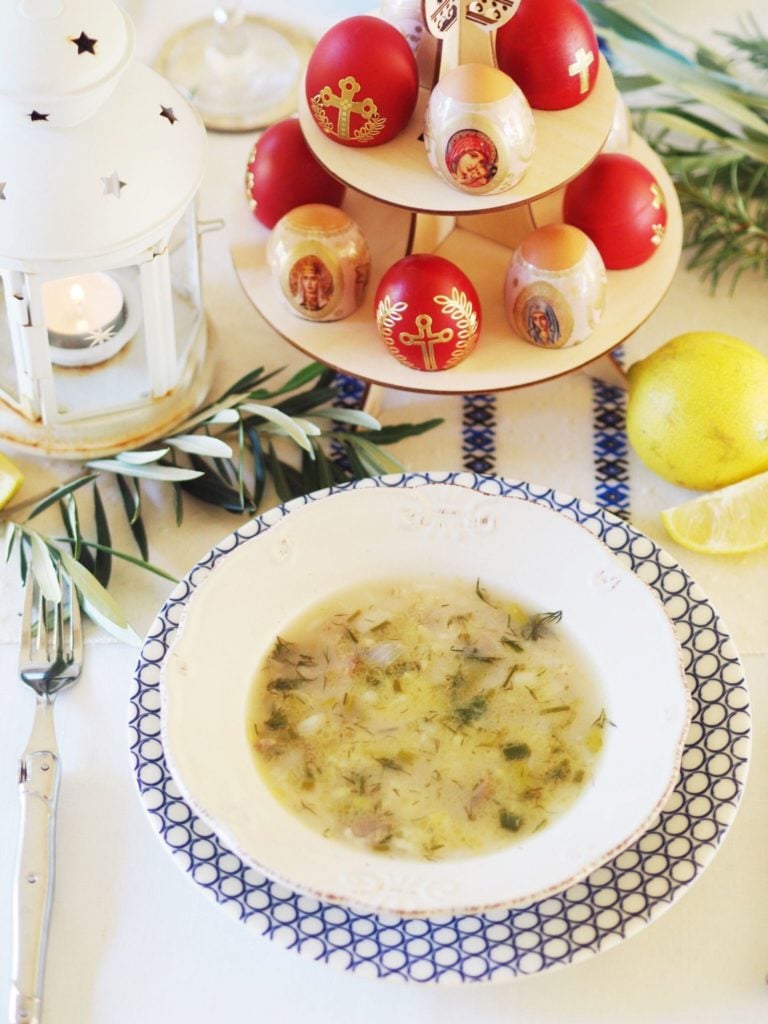It was a month before she married her Greek husband that Katerina Kallos had her first experience of Orthodox Easter.
Together with her parents, she joined her prospective in-laws on Good Friday and Holy Saturday at St Nicholas Church in Marrickville, where she recalls being immersed in the electric atmosphere, likening it to a lively Greek village.
“It was packed with beautifully dressed families, all standing under the colourful banners of Greek flags. Everyone was happy and animated, embracing family and friends alike. The warmth of the community was extended to me and my parents,” says Katerina, who is of Irish Australian heritage.
After midnight mass on Holy Saturday, they joined her now husband’s family to break the Lenten fast with a traditional meal of magiritsa (Easter soup), and was introduced to tsougrisma, the customary ‘game’ of cracking red dyed eggs by her young nephews.
“Sharing our midnight Easter meal was a beautiful way to connect both of our families and cultures ahead of our wedding.”
READ MORE: How to dye red eggs naturally
Since marrying, Katerina has adopted the traditions as her own, commencing on Holy Thursday when the family comes together to dye and decorate the eggs and bake tsoureki.
“It’s a lovely ritual that my own mum also enjoys joining in,” Katerina says. “She is an artist and her eggs are always quite spectacular! In keeping with tradition, we always place the first red egg on our home’s iconostasis.”
READ MORE: Celebrating Easter, as if in Greece
For the main event on Easter Sunday, the family gets together for a feast of epic proportions, the centrepiece dish either a succulent spit or oven-roasted goat that has been marinated in lemon, extra virgin olive oil, oregano and a touch of her mother-in-law’s famous chilli purée.
“To accompany the roasted meat there is always a huge bowl of tzatziki (my sister-in-law makes the best!), patates fournou (baked potatoes), fresh salads and other traditional dishes such as yemista and spanakopita (spinach pie),” she says.
“The feast usually lasts for many hours and finishes with Greek coffee, tsoureki and koulourakia. There are always plenty of leftovers and my colleagues usually enjoy some tsoureki and koulourakia on the Monday!”
But beyond time spent with family around the table, Katerina says every year there is something particularly special about Saturday night mass.
“Watching the Holy candlelight slowly move from person to person in the darkened church as the priest announces Christos Anesti (Christ has risen) is so moving and the moment I enjoy most each Easter,” she says.
“It is always such a beautiful sight to see hundreds of candle flames moving from the church to homes across Marrickville and beyond.”
RECIPE: Magiritsa
Magiritsa is traditionally served after midnight mass on Easter Sunday to break the fast of the 40 day lent period.
While it can be a decisive dish, due to the inclusion of intestines and liver, Katerina says her mother-in-law, Sophia’s recipe is generally well-loved in their home.
“Using plenty of fresh herbs such as dill and lemon is definitely the secret! However, for some people it’s not the taste or texture of the soup that is confronting, but rather the thought spending time in the kitchen preparing all those intestines or liver! If it makes you feel a bit squeamish then lamb shanks are a good alternative and also make a beautiful, traditional tasting soup!”
Below is a variation of Sophia’s recipe.
“If you are making this dish for Easter, it is best to prepare most of it beforehand. When everyone comes home from midnight mass, you can whip up the egg lemon sauce,” recommends Katerina.

Servings 4
Ingredients:
1 sikotaria (lamb liver) or three medium lamb shanks, thoroughly cleaned
1 onion
2 sticks celery plus leaves, roughly chopped
5 spring onions, small trimmed and finely chopped
6 shallots/scallions, finely chopped
1 espresso cup Carolina rice, soaked in warm water for 10 minutes and rinsed
1/2 bunch fresh dill, finely chopped
1 L homemade chicken stock
2 egg yolks
3 lemons, juiced
Sea salt and black pepper corns to taste
Extra virgin olive oil
Method:
· Prepare the liver or shanks
1. Put the liver or shanks in a large pot with celery and onion. Season with salt and black peppercorns. Cover with water and bring to the boil. Simmer the liver for 20 minutes or the shanks for around 2 hours, skimming the surface of any scum.
2. Strain, reserving the broth (there should be about 1 litre). Discard the aromatics.
3. Cut the liver or shanks into small pieces and set aside, covered with clingfilm.
· Prepare the soup
1. In a clean pot, saute the spring onions and scallions in the extra virgin olive oil.
2. Add the chopped liver or shanks.
3. Add the reserved broth and chicken stock and bring to the boil.
4. Add the rice, season to taste.
5. Simmer uncovered for around 20 minutes or until the meat is very tender.
6. Add the dill and stir well. Turn off the heat.
· Prepare the avgolemono
1. In a separate bowl, whisk the egg yolks, adding a little lemon juice at a time.
2. Take the soup off the heat and ladle out a little of the broth.
3. Gently pour the hot stock from the ladle into the egg-lemon mixture, continuing to whisk.
4. Finally, pour the egg lemon sauce into the pot of soup and slowly stir. Serve immediately.
For more delicious recipes, visit http://mulberrypomegranate.com/
READ MORE: A hands-on approach to the Greek Orthodox Church: Prosfora and Palm Sunday









